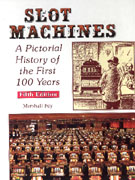The History of Slot Machines
Slot Machine Origins
Charlie Fey - Father of SlotsSlot Machine EvolutionGreat Slot InnovationsHistory of Progressive SlotsFind Loose Slots... Play Online!
Roxy Palace has some of the loosest slots on the web. Their selection is huge and with less overhead, employee costs and taxes than your typical brick and mortar casino, they can afford to give back a bigger percentages of bets back to the customer. If you're looking for loose slots, play online!

Slot Machines: America's Favorite Gaming Device
by Marshall Fey
The complete and colorful story of coin-operated chance machines from the time they first became prevalent in the early 1890's up to the slot machines operated in today's casinos. Included in the exciting drama of this major industry are the pioneer, inventors, manufacturers, operators and the numerous raids that plagued the industry. This book has been used as a source book worldwide, including television documentaries.
Read a review of Slot Machines: America's Favorite Gaming DeviceThe Origins of Slot Machines
Slot machines are popular, and no wonder – they're easy to play, they're exciting and colorful, and they don't need a rulebook. A visitor to any modern American casino can see that slots and video poker dominate the casino floors, usually taking over 75% of the space available. In every state where casinos are allowed, slots provide the majority of the revenue to the casino operators and since they don't take as much manpower to run as table games, they also are the main source of profit. States looking for new revenue sources or to rescue failing racetrack operations are turning to slot machines as the solution. How slots became so popular is a story that goes back over 100 years. It is a story of innovation, shifting gambling lifestyles, and technological breakthroughs.
Slot machines trace their beginnings to the end of the 19th century when the development of coin-operated machines met up with the wide-open gambling world of San Francisco. With the gold rush of the 1850s and the silver mining boom in Virginia City from the 1860s to the 1880s, gamblers of all sorts were pulled West to find their fortunes. In this atmosphere, saloons and gambling halls sprung up all over San Francisco, particularly in the nefarious Barbary Coast.
In a short span of years, machines manufactured first on the East Coast and later in the West proliferated in the liberal gambling climate of San Francisco. It wasn't long before the machines spread throughout the California, Nevada, and later, the country. The history of this boom is filled with invention and larceny, expansion and consolidation, betrayal and corruption, and vast fortunes made and lost. It is a history that mirrors many of the boom and bust industries that have been spawned in the United States.
Beginning in 1879 with nickel-in-the-slot machines such as early jukeboxes, tobacco packers, and arcade machines, the Clawson Machine Company of Newark, New Jersey became a leader in coin-operated machines. They brought out their first “chance” machine called Automatic Dice in 1891. This machine shook dice and paid awards in cigars and drinks. These machines were dubbed “trade stimulators,” not gambling machines, because no money was paid out to the customer. With this loophole, saloon and cigar store owners worked with nickel-in-the-slot manufacturers to offer more and more machines to their customers.
The success of these early chance machines encouraged many more manufacturers to join the growing business. Chance machines began to appear in many forms. In 1891, Clawson developed Three Jackpot, a pocket machine in which coins fell through bounced pins. If the coin bounced into one of three cups, the player won a pot of coins.
In the same year, Sittman and Pitt of Brooklyn began to manufacture the first nationally known poker card machines. Most of these early models, called drop card machines, employed 50 cards on 5 drums. The machines were two cards short of a complete deck, usually the jack of hearts and the ten of spades, which cut the possibility of a Royal Flush in half. Upon inserting a nickel and pushing the handle lever, the drums would spin and rotate the cards. When the reels stopped and the hand lined up, the player could determine if he had won. A winning hand could pay up to 100 cigars or drinks for a Royal Flush (enough for a festive wedding party), 40 for a Straight Flush, and lesser awards for a pair of Kings or better. Often cards were rearranged on the reels by prudent saloon owners to further reduce wins. Award cards were often printed on both sides with separate pay schedules for free drinks and cigars.
These machines and those of many other manufacturers took San Francisco by storm. They were so popular that by 1896 the machines were in virtually every one of the city's over 3,000 licensed liquor establishments (one license for every 96 residents). A newspaper headline that year asked, "Who hasn't dropped a nickel in the slot of these seductive little machines found in almost any place where men most do congregate?"
Around the same time, the New York Company and their agent, cigar dealer Charles Leonhardt, Jr., formed the Monarch Card Machine Company and quickly introduced some of the most prominent games of the day. The Monarch Brownie was the first machine to use a front bottom window to display all nickels played, and to hold the last one in sight. The latter feature was incorporated to discourage the use of counterfeit coins, a scourge that had plagued the industry since its inception.
In 1894, Charles August Fey, a German immigrant trained as a machinist, built his first slot machine. It was a three-wheel machine and was very similar to one first made the previous year by Gustav Shultze, a known manufacturer and operator of slots. The same year, Fey and Theodore Holtz, a co-worker, quit their jobs at California Electric Works and formed a new company to compete with their former employee. The new business was located on the same block as Shultze's slot manufacturing company and undoubtedly manufactured parts for Shultze's machines.
In 1895, Fey moved to Berkeley, where he built his second slot machine in the basement of his new home. This machine, called the 4-11-44, was based on Policy, a popular lottery game at the time. The machine had three concentric numbered dials, and was set on a long and narrow cabinet. 4-11-44, which was a popular sequence in Policy, was the top paying combination and paid $1.00.
The first 4-11-44 was placed in a saloon, and became so popular that Fey promptly created a few more, and decided to devote his full time to designing and manufacturing slot machines.
In 1896, Fey formed a factory on Market Street in San Francisco. It was here, in 1899, that the "Thomas Edison of Slot Machines" built the three-reel Liberty Bell, the forerunner of more than a million bell slot machines that would be manufactured over the next half century.
The story of how Fey's bell slot machines came to dominate the gaming world will continue in the next installment of our slot history.
About this article
This description of early slot machine history is entirely indebted to Slot Machines: an Illustrated History of America's Most Popular Coin-Operated Gaming Device. The book was originally written in 1983 by Marshall Fey, grandson of the man many credit with inventing the modern slot machine, Charles Fey. You can read a much more detailed account of this period along with the full history of Fey's grandfather's machines, as well as marvel at the designs from slots' early days in this engaging book.
Editor's Note: As a boy, I often had dinner with my parents at the Liberty Belle in Reno, where Mr. Fey displayed a collection of his grandfather's and other antique slot machines. These machines were wonders of the past. I can recall that some were for “amusement only” which gave me a chance to put a nickel-in-the-slot and pull the lever. It gave me quite a thrill.

